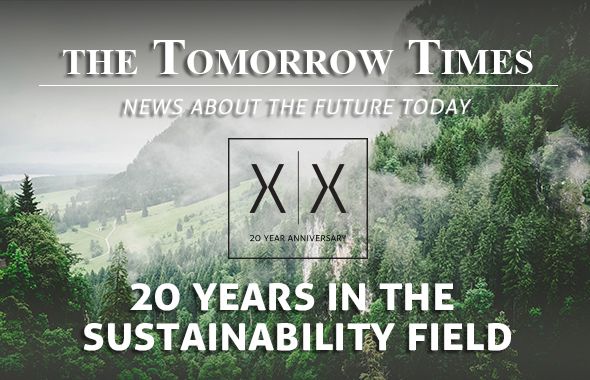Except turns 20 this month. This Tomorrow Times looks back two decades in the sustainability field, and wonders: what happened? Sustainability went from niche to buzzword, and now sustainable development is on a journey to establish itself as the new normal.
This month, we look back at the achievements that are contributing in changing the rules of production and consumption systems, and in questioning our relationships with our broader environment. We do so by navigating the trends and milestones that gained the spotlight in the sustainability conversation in the last 20 years and by sharing a monthly digest of latest happenings.
On Friday, Sep. 20th we celebrate Except Integrated Sustainability's 20 years of pioneering sustainable development. Register here to join the event in Utrecht.
Follow these periodical monthly updates of tomorrow’s sustainability news today, by subscribing to the Tomorrow Times.
A 20 year journey through sustainable development
- The rise of circular economy and servitization. A circular economy is a deep-rooted concept, based on the principles of designing out waste and pollution by keeping products and materials in use. Its applications have been gaining momentum since the late 1970s, developing over the years in often complementary schools of thought. One of the practical applications of ‘circular economy’ can be identified in the servitization: reducing material needs by changing a product’s ownership in favour of having access to its service/s. An example from the business-to-business market is when Philips provides light as a service to Schiphol Airport.
- The decline of single-use plastic products. Over the past 50 years, the role and importance of plastics in our economy has grown. Global production of plastics has increased twentyfold since the 1960s. The awareness that the management of plastic plays a central role in the future of sustainability has recently gained foothold: between 2010 and 2019, the number of public policies intended to phase out plastic bags tripled. In January 2018, the European Commission adopted the first-ever ‘European Strategy for Plastics in a Circular Economy’, followed in March by a ban on throwaway plastics by 2021. This May, 180 countries reached a deal to counteract plastic pollution in our oceans.
- Climate change and land management. This month, the Intergovernmental Panel on Climate Change (IPCC) has released the first-ever comprehensive look at the whole land-climate system. A special report on climate change, desertification, land degradation, sustainable land management, food security, and greenhouse gas fluxes in terrestrial ecosystems. Land is a critical resource under growing human pressure – we rely on it for food, water, health, and wellbeing. The report shows that better land management can contribute to tackling climate change. Agriculture, forestry and other land use represent 23-37% of total net anthropogenic emissions of GHGs.
- Regenerative agriculture. Farming is as well responsible for a substantial share of biodiversity loss - as reported this May by IPBES (Science-Policy Platform on Biodiversity & Ecosystem Services). Regenerative agricultural practices build soil health and contribute to biodiversity, while yielding nutritious and profitable products, represent an encouraging direction for a systemic shift. One exemplary practice is the use of cover crops - crops that prevent soil from wind and water erosion, reducing the evaporation of soil moisture while attracting beneficial insects and birds.
- Urban development and Nature-based solutions. Cities are the main consumers of resources and the main producers of waste but also the innovation engines of the world. Acknowledging the need for urgent collaboration, hundreds of architects have recently joined a new movement to declare “climate and biodiversity emergencies”. This movement is translated into practice by various means - e.g. green and blue infrastructures, urban agriculture, re-zoning and regeneration of degraded areas. Regenerative urban design reconnects people with nature by integrating ecosystem services. It is a holistic approach that wires architectural planning with the natural processes that sustain life - the site, climate, resources, energy, fauna and flora, etc.
- Recalling some achievements of the last 20 years.
- In 1999, the Dow Jones Sustainability Indices (DJSI) are launched, becoming the first mainstream sustainable investment indices.
- In 2000, the UN Global Compact encourages businesses worldwide to adopt sustainable and socially responsible policies, and sets the 8 Millennium Development Goals (MDGs) to be achieved by 2015. In the same year, the full version of the Global Reporting Initiative (GRI) is released, setting guidelines for sustainability reporting.
- In 2006, California imposes a limit on greenhouse gas emissions; the following year, the EU agrees to cut CO2 emissions by 20% by 2020, compared to 1990 levels.
- In 2015, the 17 Sustainable Development Goals (SDGs) are launched, becoming the blueprint to achieve a better and more sustainable future.
- In 2016, the Paris Climate Agreement is signed, setting a global goal of limiting global warming to below 2°C.
Energy & Environment

- The Amazon is on fire: what is going on, and what can we do about it? Fires happen every year, but the peak day this month was 700% higher than the average. The fires are mostly illegal and they are burning the world’s biggest terrestrial carbon sink and biodiversity hotspot to ashes. They also contribute to the alarming rise in deforestation rates: only over July, an area larger than Greater London was deforested. What can individuals do? As consumers, think twice before buying consumer products, unless certified by groups such as Rainforest Alliance, and donate to organisations that support the forest, forest dwellers and biodiversity.
- Costa Rica powered by nearly 100% renewable energy. Costa Rica aims at net-zero carbon emissions by 2050. For the first time in May, it produced nearly 100% of its energy from renewable sources. At the same time, in the first half of 2019 renewable energy sources produced 20% of electricity in the US. In the UK, the remaining coal-fired generation plants are set to close in the coming years.
- Hawaiian coral reefs are returning to their former glory. It’s been hypothesized that there was not much hope for these areas. But now, after years of federally mandated protection, scientists see signs that this once ecologically fertile ecosystem is recovering.
Business & Economy

- 4th largest chain of supermarkets in the UK goes packaging free. Morrison is to become the first supermarket chain to remove packaging from its fruit and vegetables. The company said customers would be able to choose from up to 127 varieties of fruit and veg in many of its stores, buying them loose or using recyclable paper bags.
- The market for electrical trucks is expanding. Electric bus maker Proterra is looking to sell its systems to commercial truck and heavy-duty vehicle makers. The potential market includes public vehicles that are "high mileage and inefficient" as garbage trucks, urban delivery vehicles and school buses. Proterra highlights important trends across the electrification of transportation: urban commercial vehicles are prime to electrify as the costs of batteries drop, and public agencies strive to hit sustainability goals.
- Future businesses innovation requires generalists. Businesses need people with wide horizons and ranges of interests in order to succeed. Focusing too narrowly is not always the solution. Circularity requires system thinking, interdisciplinary teamwork is on the rise. What level of specialization is truly needed to optimize the sustainability transition? An internationally renowned scientist, Arturo Casadevall, believes that increasing specialisation has created a “system of parallel trenches”. Everyone is digging deeper into their own trench, rarely standing up to look into other fields.
Science, Technology & Design

- Sustainable sneakers from recycled and renewable materials. The sneaker industry is bigger than ever, and its growth shows no signs of slowing. Most of these new pairs use virgin plastic, rubber, and petroleum, producing carbon dioxide. Check out 8 brands making more sustainable sneakers.
- The air conditioning of the future: a starry night and no electricity. Scientists are rethinking air conditioning to create cool air without any electricity using radiative cooling, a concept used in the ancient Middle East. To understand how radiative cooling works think about the night sky: once the sun has set and the cooler evening begins, the soil, the grass, the roofs of homes, even people, give off heat into the deep space. A clear night sky radiates away more heat than the whole sky is sending back down to Earth.
- Plastics producer promotes innovative solutions to tackle ocean pollution. ‘Dow - Material Science and Innovation’, is supporting a circular collaborative model looking for institutional investments. Dow’s model, if scaled, should initiate integrated, profitable recycling and waste management projects that not only provide a solution to marine debris, but also offer an attractive financial return to investors.
Urban Environment

- World's largest urban farm to open on a Paris rooftop. “The goal is to make the farm a globally-recognised model for sustainable production,” says Pascal Hardy, founder of Agripolis, the urban-farming company at the centre of the project. Currently under construction in the south-west of the city, this urban oasis will span approximately 14,000 m2, growing more than 30 different plant species, using entirely organic methods.
- Gree-Blue infrastructure saves Alicante from floods. In Alicante it never rains - it pours. The city in southeast Spain goes without rain for months, but when it comes it’s torrential, resulting in destructive flooding. To protect itself, the city has built a park designed with a twist. It serves as a typical recreation area and a nature reserve, but its primary purpose is to store, and then recycle, rainwater.
- Africa is set to get its first vertical forest. The Egyptian desert is set to host the African continent's first vertical forest. Italian architect and urban planner Stefano Boeri has unveiled designs for three buildings covered with pollution-absorbing trees and plants in Egypt's New Administrative Capital, which is under construction in the desert east of Cairo.
Unexpected and Intriguing

- Growing food underwater, a solution to climate change? To show what’s possible when people try to find new ways of tackling climate change and restoring nature, a collaboration was formed between the World Economic Forum, WWF and Netflix. Watch the first video in the series here: the seaweed farmer who wants to feed the planet.
- Women for sustainable land management. Many of the world’s threatened forests are collectively owned and managed by small community groups. Women frequently have no decision-making powers in those groups. A new study has concluded that gender quotas for local governing bodies could help reduce deforestation while addressing local inequalities at the same time.
- ‘FILTRATION’: a floating skyscraper to recycle ocean garbage. This floating skyscraper imagined to clean up our seawater has received the honourable mention in the ‘evolo 2019 skyscraper competition’.
Have you seen a news item suited for 'The Tomorrow Times'? Let us know and we'll consider including it in the next edition.
CELEBRATE WITH US | CLICK ON THE IMAGE BELOW

Sept. 12, 2019

